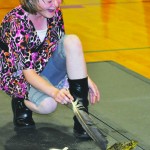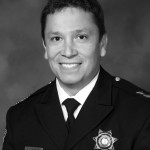
Article and photos by Sarah Miller
When most people think of child support, they think of court battles with angry parents looking to get as much money as they can from the other. In fact, child support is not a payment due to the parent; it is money to help support the child. Children are expensive to raise. They need food, clothes and a roof over their head. Tulalip Child Support Program (TCSP) aims to get the child what they need while they grow up. It is a benefit for the child, not the parent.
At this month’s community meeting, Child Support Enforcement was up to bat to talk about the (TCSP). During the meeting, staff members from the department took time to discuss the inner workings of child support and also answered questions that the audience had.
“This program enforces a child’s right,” said Intake Clerk Shaena Mitchell. “Children are our highest priority.”
The Tulalip Tribes is the 33rd tribe in Indian Country to have a tribal child support program. This program and its workers aim to build strong and committed partnerships, provide public education and outreach, and promote a stable, safe and healthy relationship between parents and children.
“I have worked with Child Support Enforcement since 2010,” said Program Attorney Sarah Colleen Sotomish. “I am very pleased to be working here. Over the past few years since this program started, our staff has grown. We are now seven people strong. We have just scratched the surface of what we have and what we can do in this program.”
At the moment, there are 780 cases waiting to transfer from the state to Tulalip. The current caseload at Tulalip is 810. Cases are doled out depending on the caseload of the staff member.
“We represent the child, not the parent,” said Case Manager Christy Schmuck-Joseph. “We can offer paternity establishment, genetics testing, adding father to birth certificate, child support establishment, modifications, and resources.”
To get paternity established, a summons must be filed and petitioned. Sometimes, a motion and order is required for the alleged father to submit to genetic testing.
A lot of the talk at the meeting was about Child Support Orders (CSO). In order to establish a CSO, a summons and petition must be filed by the case manager. All child support obligations will be based on the child support guidelines, however TCSP will make recommendations as to the child support obligation and amount. It must be based only on the guidelines.
You can also modify a CSO, which would require both parents going back to court. Modifications are made due to substantial increase in gross income, change in custody, change in TCSP guidelines, if it’s been two years since the last modification and other substantial change in circumstances.
“Sometimes all of this can take awhile,” said Lead Case Manager Lorna Edge Onsel. “It can take a long time if we can find the parent. We always appreciate any help when trying to locate a parent. We also enforce orders. Enforcement works when the non custodial parent has missed payment for three months. When that happens, we can take from per capita. We also do payroll deductions.”
Though the meeting lasted roughly an hour, many questions got answered and a lot of information was given to the audience. If you need any assistance from Child Support Enforcement, you can call 360-716-4556.







